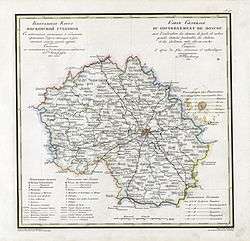Moscow Governorate
| Moscow Governorate Московская губерния | |||||
| Governorate of Russian Empire | |||||
| |||||
|
| |||||
 | |||||
| Capital | Moscow | ||||
| History | |||||
| • | Established | 1708 | |||
| • | Disestablished | 1929 | |||
| Population | |||||
| • | 1897 | 2,430,581 | |||
Moscow Governorate (Russian: Московская губерния; pre-reform Russian: Московская губернiя), or the Government of Moscow, was an administrative division (a guberniya) of the Tsardom of Russia, the Russian Empire, and the Russian SFSR, which existed in 1708–1929.
History
Moscow Governorate, together with seven other governorates, was established on December 29 [O.S. December 18], 1708, by Tsar Peter the Great's edict.[1] As with the rest of the governorates, neither the borders nor internal subdivisions of Moscow Governorate were defined; instead, the territory was defined as a set of cities and the lands adjacent to those cities.[2]
Subdivisions
| # | City | # | City | # | City |
|---|---|---|---|---|---|
| 1. | Moscow | 14. | Lyubim | 27. | Suzdal |
| 2. | Aleksin | 15. | Medyn | 28. | Tarussa |
| 3. | Borovsk | 16. | Mikhaylov | 29. | Tsarev Borisov |
| 4. | Dedilov | 17. | Mozhaysk | 30. | Tula |
| 5. | Dmitrov | 18. | Obolensk | 31. | Veneva |
| 6. | Gremyachey | 19. | Pecherniki | 32. | Vereya |
| 7. | Kaluga | 20. | Pereslavl Ryazanskoy | 33. | Volodimir |
| 8. | Klin | 21. | Pereslavl Zaleskoy | 34. | Volokolamsk |
| 9. | Kolomna | 22. | Pronsk | 35. | Yaroslavets Maly |
| 10. | Koshira | 23. | Rostov | 36. | Yepifan |
| 11. | Kostroma | 24. | Ruza | 37. | Yuryev Polskoy |
| 12. | Krapivna | 25. | Serpukhov | 38. | Zaraysk |
| 13. | Lukh | 26. | Shuya | 39. | Zvenigorod |
The governorate underwent numerous changes in the following years, and was finally abolished on January 14, 1929 when modern Moscow Oblast was created.
Demography
Language
- Population by mother tongue according to the Imperial census of 1897.
| Language | Number | percentage (%) | males | females |
|---|---|---|---|---|
| Russian | 2,371,102 | 97.5 | 1,181,296 | 1,189,806 |
| German | 19,116 | 0.7 | 9,225 | 9,891 |
| Polish | 10,960 | 0.4 | 7,676 | 3,284 |
| Jewish | 5,756 | 0.2 | 3,795 | 1,961 |
| Ukrainian | 5,506 | 0.2 | 4,838 | 668 |
| Tatar | 5,469 | 0.2 | 4,492 | 977 |
| French | 2,621 | 0.1 | 1,035 | 1,586 |
| Armenian | 1,633 | 0.0 | 1,201 | 432 |
| Belarusian | 1,292 | 0.0 | 948 | 344 |
| English | 1,135 | 0.0 | 559 | 576 |
| Latvian | 1,018 | 0.0 | 731 | 287 |
| Lithuanian | 690 | 0.0 | 600 | 90 |
| Czech | 636 | 0.0 | 397 | 239 |
| Gypsy | 511 | 0.0 | 249 | 262 |
| Estonian | 396 | 0.0 | 243 | 153 |
| Italian | 374 | 0.0 | 220 | 154 |
| Greek | 292 | 0.0 | 241 | 51 |
| Swedish | 228 | 0.0 | 117 | 111 |
| Chuvash | 152 | 0.0 | 147 | 5 |
| Komi | 148 | 0.0 | 144 | 4 |
| Bulgarian | 110 | 0.0 | 100 | 10 |
| Other | 1,436 | 0.0 | 1,013 | 423 |
| Total | 2,430,581 | 100.0 | 1,219,267 | 1,211,314 |
Religion
- According to the Imperial census of 1897.[3]
| Religion | Number | percentage (%) | males | females |
|---|---|---|---|---|
| Pravoslavs[4] | 2,272,145 | 93.5 | 1,139,289 | 1,132,856 |
| Old Believers and others split from Pravoslavs | 99,825 | 4.1 | 44,682 | 55,143 |
| Lutherans | 21,437 | 0.8 | 10,701 | 10,736 |
| Roman Catholic | 17,670 | 0.7 | 11,497 | 6,173 |
| Judaism | 8,704 | 0.3 | 5,400 | 3,304 |
| Islam | 5,605 | 0.2 | 4,678 | 927 |
| Reformed | 2,218 | 0.0 | 1,088 | 1,130 |
| Armenian Gregorians | 1,640 | 0.0 | 1,188 | 452 |
| Anglicans | 838 | 0.0 | 441 | 397 |
| Karaites | 347 | 0.0 | 210 | 137 |
| Armenian Catholic Church | 25 | 0.0 | 18 | 7 |
| Buddhists, Lamaists | 11 | 0.0 | 11 | 0 |
| Mennonites | 3 | 0.0 | 3 | 0 |
| Other: Christian denominations | 103 | 0.0 | 52 | 51 |
| Other: non-Christians | 10 | 0.0 | 9 | 1 |
| Total | 2,430,581 | 100.0 | 1,219,267 | 1,211,314 |
References
- 1 2 Указ об учреждении губерний и о росписании к ним городов (in Russian)
- ↑ С. А. Тархов (2001). "Изменение административно-территориального деления России за последние 300 лет". Электронная версия журнала "География".
- ↑ Religion Statistics of 1897 (in Russian)
- ↑ Eastern Orthodox, including Russian Orthodox, Greek Orthodox, and Georgian Orthodox
Further reading
- William Henry Beable (1919), "Governments or Provinces of the Former Russian Empire: Moscow", Russian Gazetteer and Guide, London: Russian Outlook – via Open Library
![]() Chisholm, Hugh, ed. (1911). "Moscow (government)". Encyclopædia Britannica (11th ed.). Cambridge University Press.
Chisholm, Hugh, ed. (1911). "Moscow (government)". Encyclopædia Britannica (11th ed.). Cambridge University Press.
Coordinates: 55°45′06″N 37°37′04″E / 55.7517°N 37.6178°E
.png)